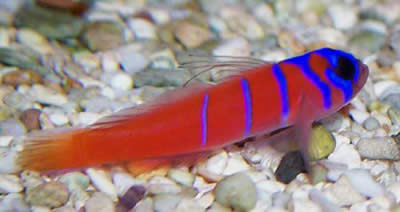Gobies live in holes either found or dug from the sand which serves as a place to bolt into when danger is near, while the Dartfish or Dart Gobies (which are not bottom oriented), swim above their protective caves!
The Gobies comprise a very large family of fish about which little is known. They are similar to the blennies with long, blunt heads, except they are usually more colorful. Their pelvic fins are fused to provide a ‘suction disc’ which they use to perch on rocks and the sea floor. The Dartfish, also known as Dart Gobies, swim above the rockwork. They are primarily meat eaters so brine shrimp and finely chopped meat or fish can be fed in the aquarium.
It is usually very difficult to tell males from females though during spawning males may change color and its fins may elongate during the spawning period. This is not the case with all species though. Spawning occurs in borrows or caves with the eggs being guarded by the male. Several species have been spawned in aquariums including Gobiosoma oceanops, and Lythrypnus dalli.
For more Information on keeping marine fish see:
Guide to a Happy, Healthy Marine Aquarium





